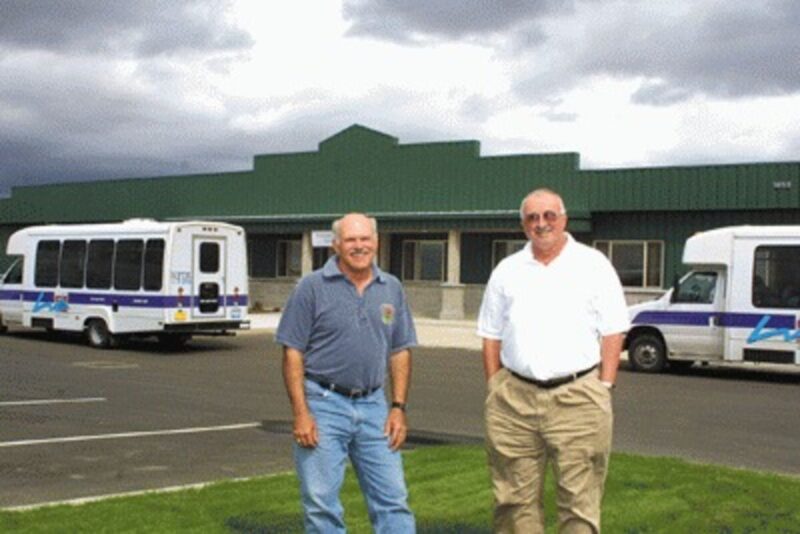Alex Paul
The workman picks up the wooden disk, about the size of a medium pizza pie, moves it quickly across the sander whirling round and round and runs his hand over it, feeling for imperfections.
Feeling none he flips the disk over, repeating the process and then tosses the piece onto the ever-growing stack.
Soon, another employee will pick up the load, cutting round holes into the disks to create a part for a shipping container.
This day, like any other Monday through Friday, dozens of persons are at work at the Willamette Valley Rehabilitation Center west of Lebanon. A day of work for some of the 120 adults in Linn county with special needs.
But, Wednesday was also a day to show off the new 50,000 square foot office and production facility.
The first sheltered workshop of its kind in Oregon now is the first to construct its own facility designed and constructed specifically to meet the training and employment needs of persons with disabilities.
On a tour of the new facility, Charles Eaton says he was so impressed with the mission of WVRC when he was a private consulting engineer, that he gave up his business and joined the team. He’s now an administrative assistant to facility manager Martin Baughman.
“It’s an amazing organization to work for,” Eaton said.
Built at a cost of just $60 per square foot, the new facility cost about $3.1 million.
The main office complex, while not ostentatious is bright, welcoming and professionally done.
The entire complex meets the Americans with Disabilities Act requirements from the front door to the back loading dock.
All rooms are wire and set up for computerization.
The new facility is a leap from the former dance hall east of town that housed the program for more than 40 years.
Executive Director Martin Baughman said that while the new facility is a major improvement in terms of working operations, the biggest improvement is in the health and safety of the workers.
Baughman said the new facility allows clients easy and safe access to buses and other vehicles without having to worry about traffic moving by on Hwy. 20.
“Now, it’s so nice to come to work and know that our clients are totally safe and secure,” Baughman said. “The fire, life and safety issues are taken care of. I can enjoy the day. Our folks are safe.”
Former Sweet Home resident Greg Morse is the senior member of the WVRC board of directors, serving since 1986.
“I’m extremely proud of the accomplishment here,” Morse said. “I’m proud to be a part of the WVRC mission.”
Morse, a retired businessman, said the unemployment rate for persons with disabilities, is more than 50 percent.
“That’s unacceptable,” he said. “Here, we’ve created an opportunity to employ up to 150 persons.”
The key to the WVRC success is the ability to diversify quickly, Morse said.
A few years ago, one of the WVRC projects was bottle and can sorting. When machinery was invented that automatically made the sort, the WVRC clients shifted to other jobs such as landscaping and janitorial projects.
“At any given time of the day or night, seven days a week, someone from WVRC is working,” director Baughman said proudly.
The main Lebanon center focuses primarily on woodworking projects, such as constructing a variety of pallets for various customers.
A new item on the line is golf course markers.
“There are more than 330 golf courses in Oregon alone,” Baughman said, reflecting on the great potential for the markers.
Other products include survey stakes and wood beams. Several products revolve around value added improvement to materials shipped in. “We’re always looking for more products,” Baughman said.
Equipment within the facility is extremely modern. One machine that rips 2 x 4s, also puts a paintable finish on them at the same time.
Rough lumber stock is lifted on a platform to the client reducing the need to bend over, thus decreasing back injuries.
Founded in 1959 and incorporated in 1961, the WVRC has been built around a deep-seated belief in the mission of “self-sufficiency through training and employment.”
Started on the vision of three persons, today’s board of directors stands fast in that belief.
“The board members contributed about 11% of the project’s cost,” Morse said. “When you take that kind of commitment to others such as foundations, it’s pretty impressive.”
Morse credited project manager and board member Steve Latimer with much of the project’s success.
Of the WVRC’s total operating budgets, 85 percent is generated by operations and 15 percent comes from government subsidies.
“The board has set a goal of making the facility 100 percent self-sufficient,” Baughman said.
Of the total $3.8 million cost of land, buildings and equipment, the WVRC owes about $1 million, Baughman said and cash flow is about at a break even point.
WVRC board members include Kay Liming, president; Rick Hayden, vice president; Greg Morse, secretary; Steve Latimer, Jeff King, Ed Kelso, Jim McDaniel, Paul Melott, Dave Bertucci, Tom McHill and Judi Taug.
Items that could be used by the WVRC include: dry material storage shed, hazardous material storage, weigh scales, shop heating system, shop ventilation system, irrigation well, fire system improvements, storage ventilation system, facility signage.
Items for client enrichment include: picnic area, covered smoking area, garden area, computer lab and arts and crafts supplies.





